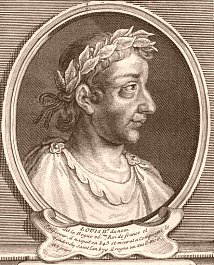Louis VI (1 December 1081 – 1 August 1137), called the Fat (French: le Gros), was King of the Franks from 1108 until his death (1137). Chronicles called him "roi de Saint-Denis".
 |
| Louis VI |
Louis was a warrior king but by his forties his weight had become so great that it was increasingly difficult for him to lead in the field. A biography - The Deeds of Louis the Fat, prepared by his loyal adviser Abbot Suger of Saint Denis - offers a fully developed portrait of his character, in contrast to what little historians know about most of his predecessors. Louis was born on 1 December 1081 in Paris, the son of Philip I and his first wife, Bertha of Holland.
Suger tells us: "In his youth, growing courage matured his spirit with youthful vigour, making him bored with hunting and the boyish games with which others of his age used to enjoy themselves and forget the pursuit of arms." And..."How valiant he was in youth, and with what energy he repelled the king of the English, William Rufus, when he attacked Louis' inherited kingdom." Louis married Lucienne de Rochefort, a French crown princess, in 1104, but repudiated her three years later. They had no children.
On 3 August 1115 Louis married Adelaide of Maurienne, daughter of Humbert II of Savoy and Gisela of Burgundy, and niece of Pope Callixtus II. They had eight children. Adelaide was one of the most politically active of all France's medieval queens. Her name appears on 45 royal charters from the reign of Louis VI. During her tenure as queen, royal charters were dated with both her reignal year and that of the king. Suger became Louis's adviser before he became king and he succeeded his father at the age of 26 on 29 July 1108. Louis's half-brother prevented him from reaching Rheims, and so Daimbert, Archbishop of Sens, crowned him in the cathedral of Orléans on 3 August. Ralph the Green, Archbishop of Rheims, sent envoys to challenge the validity of the coronation and anointing, but to no avail.
On 25 November 1120, Louis' fortunes against Henry I of England were raised when Henry's heir, William Adelin, drunkenly perished aboard the White Ship en route from Normandy to England, putting the future of Henry's dynasty and his position in doubt. By 1123 Louis was involved with a coalition of Norman and French seigneurs opposed to Henry. The plan was to drive the English King from Normandy and replace him with William Clito. Henry, however, easily defeated this coalition then instigated his son-in-law, Henry V, Holy Roman Emperor, to invade France.
 |
| Louis VI |
Henry V had married the Empress Matilda, the English King's daughter and the future mother of Henry II of England, 9 years earlier, in hopes of creating an Anglo-German empire, though the couple remained childless. Like Louis, Henry V had designs on the Low Countries and an invasion of Northern France would enable him to strengthen his ambitions in Flanders, as well as support his father-in-law.
Thus in 1124, Henry V assembled an army to march on Rheims. It never arrived. In testament to how far Louis had risen as national protector, all of France rose to his appeal against the threat. Henry V was unwilling to see the French barons united behind their King, who now identified himself as the vassal of St Denis, the patron saint of Paris, whose banner he now carried, and the proposed invasion was abandoned. Henry V died a year after the aborted campaign.
As Louis VI approached his end, there seemed to be reasons for optimism. Henry I of England had died on 1 December 1135 and Stephen of Blois had seized the English crown, reneging on the oath he had sworn to Henry I to support Matilda. Stephen was thus in no position to bring the combined Anglo-Norman might against the French crown. Louis had also made great strides in exercising his royal authority over his barons, and even Theobald II had finally rallied to the Capetian cause.
Finally, on 9 April 1137, a dying William X, Duke of Aquitaine appointed Louis VI guardian of his fifteen-year-old daughter and heiress, Eleanor of Aquitaine. Eleanor was suddenly the most eligible heiress in Europe, and Louis wasted no time in marrying her to his own heir, the future Louis VII, at the Cathedral of Saint-André in Bordeaux on 25 July 1137. At a stroke Louis had added one of the most powerful duchies in France to the Capetian domains.
Louis died of dysentery 7 days later, on 1 August 1137. Despite his achievements, it would be the growing power of the soon to be Angevin Empire that would come to overshadow his successor, its seeds sown in the marriage between the Empress Matilda and Geoffrey Plantagenet and realised through their son, Henry II of England. Louis VI was interred in the Basilica of St Denis in Paris.








